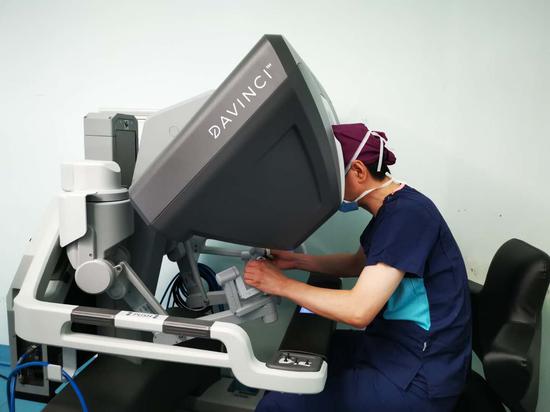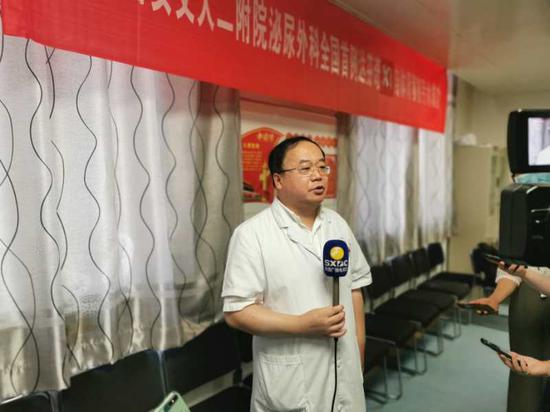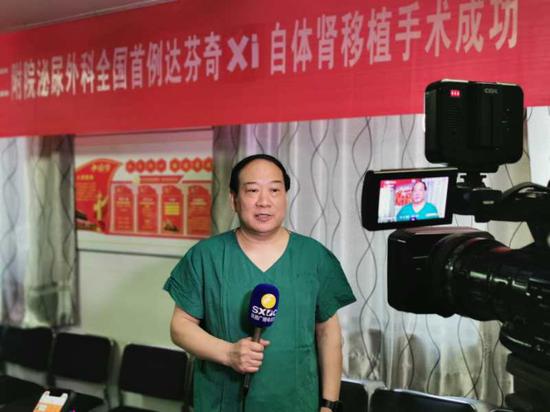Fan Cheng The first robot assisted autologous kidney transplantation in China was successfully i
Published on:2020-07-09
On the late night of July 7, the team of Professor Zhongtie of the Second Affiliated Hospital of Xian Jiaotong University successfully completed the countrys first four generation robot assisted laparoscopic autologous kidney transplantation, which marks that the robot operation ability of the Second Affiliated Hospital of Xian Jiaotong University has reached the national advanced level. That morning, the Second Affiliated Hospital of Xian Jiaotong University also held a ceremony to celebrate the breakthrough of the fourth generation Da Vinci robot surgery in the hospital. Zhong tie, director of Urology, Xue Xiang, director of Obstetrics and Gynecology, Chen Xi, director of general surgery, LV Jianrui, director of anesthesia and surgery department, and other experts shared their preliminary achievements and experiences in the application of Da Vinci technology.
Zhang, a 52 year old female patient, was treated in a local hospital because of right lumbar discomfort. Ureteroscopy and biopsy showed that the right ureteral polyp was accompanied by focal fibroepithelial papillary hyperplasia. Due to the long pathological ureter and great difficulty of operation, the patients have been transferred to many hospitals without effective treatment. Recently, the patient came to the urology department of the Second Affiliated Hospital of Xian Jiaotong University. After careful discussion, Professor Zhongties team considered that the lesion site of the patients ureter was long. If the lesion laser resection under traditional transurethral ureteroscopy or intestinal replacement of ureter were adopted, the possibility of long-term renal function injury after operation was greater; At the same time, considering that the fourth generation robot assisted laparoscopic technology in the hospital is becoming more and more exquisite, and the robot has absolute advantages in vascular anatomy and suture, fine operation and short operation time, it can shorten the renal ischemia time and protect the renal function to the greatest extent. Therefore, it is decided to implement the worlds most advanced robot assisted autologous kidney transplantation for patients. At about 11 a.m., with the help of robot, Professor Zhongtie first performed left nephrectomy for the patient, and the kidney was quickly removed from the body. Subsequently, the medical staff in the kidney repair group completed the kidney repair in vitro. During the operation, it was found that the polyp in the upper segment of the right ureter was about 8cm long, and the diseased ureter was finely removed. Finally, Professor Zhongtie used the original kidney incision to implement autologous kidney transplantation with the help of robot. The operation process was smooth. After the blood supply was restored, the transplanted kidney was ruddy and the function recovered well. The operation lasted about 10 hours. It is reported that this is also the first case of autologous kidney transplantation assisted by four generations of robots in China. The successful implementation of the operation has filled many gaps in the field of robot assisted kidney removal and robot assisted kidney transplantation in Shaanxi Province, marking that the minimally invasive technology of Urology and kidney transplantation technology of the Second Affiliated Hospital of Xian Jiaotong University have entered the national advanced ranks.

Professor Zhongtie, director of Urology, is operating robotic surgery
Professor Zhong tie, director of Urology, introduced that compared with traditional laparoscopic surgery, the robot has greatly improved the accuracy of surgery, and the surgical field of vision is completely achieved. The manipulator can complete the actions that cannot be done by human hands at will. The operation is accurate and stable, and can deal with the details and areas that cannot be handled by human hands. It has great advantages in reconstruction surgery and malignant tumor surgery. At the same time, in the future, we can also join hands with 5g communication technology to realize remote cooperative surgery in different places and serve a wider range of patients through ultra-high speed 5g network without delay.

Professor Xue Xiang, director of Obstetrics and Gynecology, was interviewed
Professor Chen Xi, director of general surgery, introduced that Da Vinci robotic surgery is the most cutting-edge form of human use of high-tech technology and clinical surgery, representing the worlds top medical technology level. However, Da Vinci surgical robot is fundamentally a more advanced laparoscopic operating system. The operator needs to have a solid foundation of endoscopic operation and rich experience in minimally invasive treatment. At the same time, we should also pay attention to identify the indications of robotic surgery, select the surgical methods that can give full play to its advantages, and maximize its value.

Professor Chen Xi, director of general surgery, was interviewed
According to Gao ya, vice president of the Second Affiliated Hospital of Xian Jiaotong University, on April 27 this year, the Second Affiliated Hospital of Xian Jiaotong University introduced the worlds most advanced fourth generation Da Vinci surgical robot. With the unremitting efforts of multiple robot surgical teams in urology, gynecology, general surgery, anesthesia and other disciplines, the hospital successfully completed 111 operations assisted by various difficult robots in more than two months, It has brought more advanced medical services to patients.
President Li Zongfang said in an interview that due to the restrictions of policies and other factors, the hospital did not introduce Da Vinci robot technology and equipment until the end of the epidemic this year. Although this technology was carried out relatively late, the clinical application of various disciplines was overwhelming, catching up with and surpassing at the speed of two operations a day. I believe that with the support of todays most advanced fourth generation robot technology, the Second Affiliated Hospital of Jiaotong University is confident to catch up, take the lead in the country in this technology, and provide patients with world-class medical technology services.
Zhang, a 52 year old female patient, was treated in a local hospital because of right lumbar discomfort. Ureteroscopy and biopsy showed that the right ureteral polyp was accompanied by focal fibroepithelial papillary hyperplasia. Due to the long pathological ureter and great difficulty of operation, the patients have been transferred to many hospitals without effective treatment. Recently, the patient came to the urology department of the Second Affiliated Hospital of Xian Jiaotong University. After careful discussion, Professor Zhongties team considered that the lesion site of the patients ureter was long. If the lesion laser resection under traditional transurethral ureteroscopy or intestinal replacement of ureter were adopted, the possibility of long-term renal function injury after operation was greater; At the same time, considering that the fourth generation robot assisted laparoscopic technology in the hospital is becoming more and more exquisite, and the robot has absolute advantages in vascular anatomy and suture, fine operation and short operation time, it can shorten the renal ischemia time and protect the renal function to the greatest extent. Therefore, it is decided to implement the worlds most advanced robot assisted autologous kidney transplantation for patients. At about 11 a.m., with the help of robot, Professor Zhongtie first performed left nephrectomy for the patient, and the kidney was quickly removed from the body. Subsequently, the medical staff in the kidney repair group completed the kidney repair in vitro. During the operation, it was found that the polyp in the upper segment of the right ureter was about 8cm long, and the diseased ureter was finely removed. Finally, Professor Zhongtie used the original kidney incision to implement autologous kidney transplantation with the help of robot. The operation process was smooth. After the blood supply was restored, the transplanted kidney was ruddy and the function recovered well. The operation lasted about 10 hours. It is reported that this is also the first case of autologous kidney transplantation assisted by four generations of robots in China. The successful implementation of the operation has filled many gaps in the field of robot assisted kidney removal and robot assisted kidney transplantation in Shaanxi Province, marking that the minimally invasive technology of Urology and kidney transplantation technology of the Second Affiliated Hospital of Xian Jiaotong University have entered the national advanced ranks.

Professor Zhongtie, director of Urology, is operating robotic surgery
Professor Zhong tie, director of Urology, introduced that compared with traditional laparoscopic surgery, the robot has greatly improved the accuracy of surgery, and the surgical field of vision is completely achieved. The manipulator can complete the actions that cannot be done by human hands at will. The operation is accurate and stable, and can deal with the details and areas that cannot be handled by human hands. It has great advantages in reconstruction surgery and malignant tumor surgery. At the same time, in the future, we can also join hands with 5g communication technology to realize remote cooperative surgery in different places and serve a wider range of patients through ultra-high speed 5g network without delay.

Professor Xue Xiang, director of Obstetrics and Gynecology, was interviewed
Professor Chen Xi, director of general surgery, introduced that Da Vinci robotic surgery is the most cutting-edge form of human use of high-tech technology and clinical surgery, representing the worlds top medical technology level. However, Da Vinci surgical robot is fundamentally a more advanced laparoscopic operating system. The operator needs to have a solid foundation of endoscopic operation and rich experience in minimally invasive treatment. At the same time, we should also pay attention to identify the indications of robotic surgery, select the surgical methods that can give full play to its advantages, and maximize its value.

Professor Chen Xi, director of general surgery, was interviewed
According to Gao ya, vice president of the Second Affiliated Hospital of Xian Jiaotong University, on April 27 this year, the Second Affiliated Hospital of Xian Jiaotong University introduced the worlds most advanced fourth generation Da Vinci surgical robot. With the unremitting efforts of multiple robot surgical teams in urology, gynecology, general surgery, anesthesia and other disciplines, the hospital successfully completed 111 operations assisted by various difficult robots in more than two months, It has brought more advanced medical services to patients.
President Li Zongfang said in an interview that due to the restrictions of policies and other factors, the hospital did not introduce Da Vinci robot technology and equipment until the end of the epidemic this year. Although this technology was carried out relatively late, the clinical application of various disciplines was overwhelming, catching up with and surpassing at the speed of two operations a day. I believe that with the support of todays most advanced fourth generation robot technology, the Second Affiliated Hospital of Jiaotong University is confident to catch up, take the lead in the country in this technology, and provide patients with world-class medical technology services.

